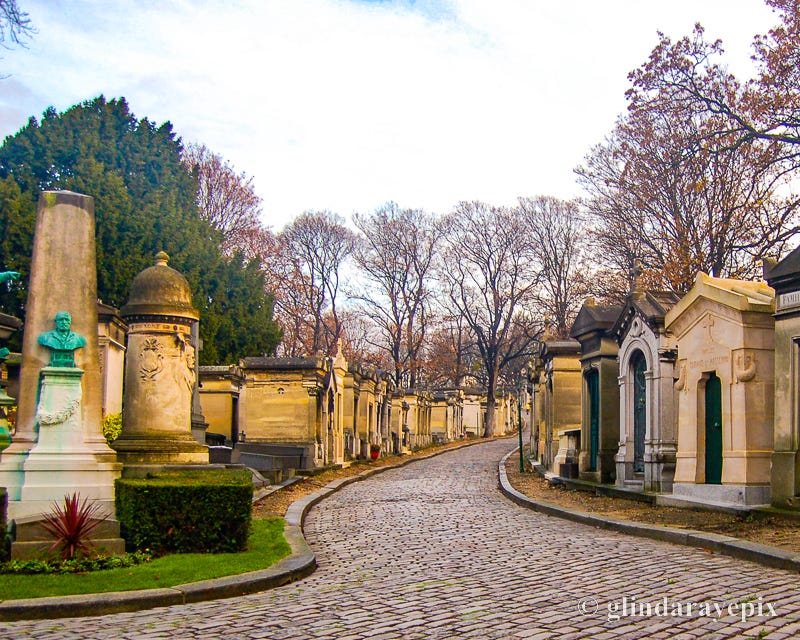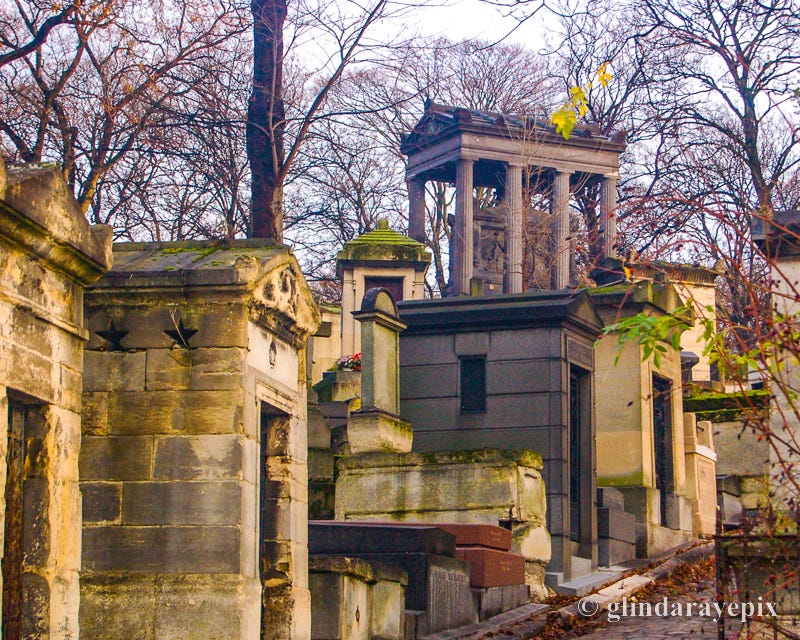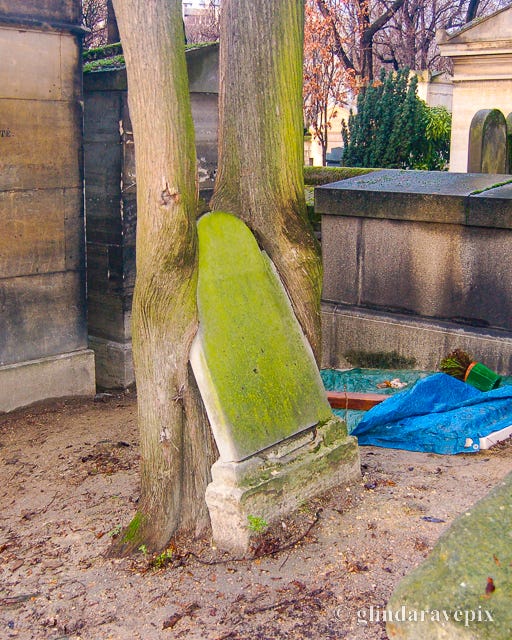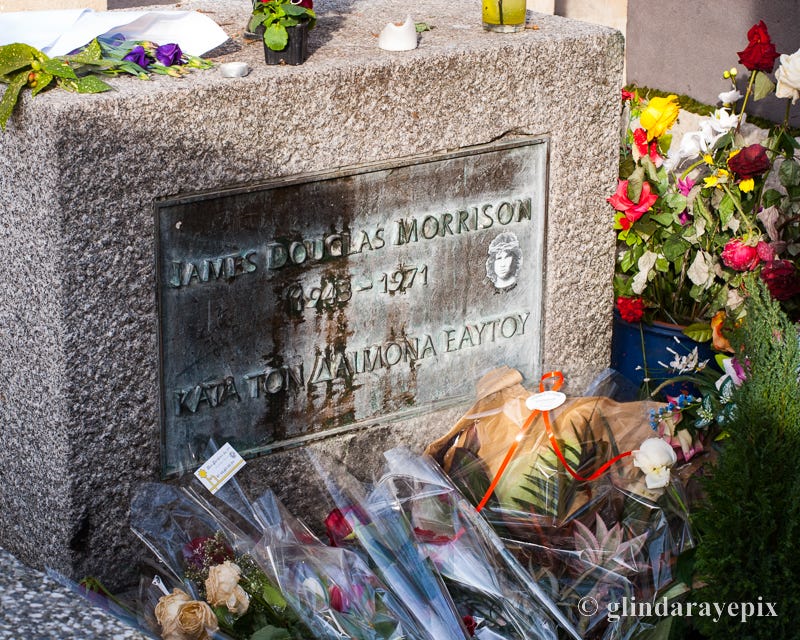We continue our Tuesday Odds & Ends features here with a random stroll around the strange and fabled Parisian premises of la Cimetière du Père-Lachaise. Most of the photos were taken at dawn, normally the best and least crowded time to see the most visited cemetery on the planet.
And—while we have your attention—if you ever have any questions about anything you read, be they informational or logistical, ask in the Comments section. We answer all queries.
When the authorities post a closing time in a Parisian cemetery, it's wise to pay attention. Or so we discovered one winter evening, when we got stuck inside la Cimetière du Montparnasse. We'd gone to find the graves of Jean-Paul Sartre and Simone de Beauvoir, and had just stumbled onto the tombstone of Lieutenant-colonel Alfred Dreyfuss, when the huge, iron gates slammed shut. We spent an hour in the gathering gloom before our own liberation, contemplating the unfortunate Jewish artillery officer whose trumped-up, thoroughly anti-Semitic conviction in 1895 for espionage nearly destroyed the French Republic.
Our mini-drama aside, the cemetery at Montparnasse and the even more exclusive Panthéon of the Quartier Latin might host the remains of some fascinating characters, but their clean, straight lines and immaculate premises give them a sometimes sterile and anti-climactic feel. Or so it seems after taking the eastern Metro Line 3 out to the legendary upheaval of la Cimetière du Père-Lachaise.
Of all the cemeteries of Paris (and maybe the world), Père-Lachaise is the most provocative, chaotic, and—odd as it sounds—most vibrant necropolis ever built. No one knows exactly how many graves it contains—somewhere between 300,000 and 1.2 million, depending on how you count. Opened in 1804 at the height of the Napoleonic Empire, its rolling hills and dense gardens are packed with the luminaries of Paris and France. Yet, for all the fame and notoriety of its occupants, the cemetery itself is the center ring of its own flamboyant circus.
You can still be buried here, as long as you live in Paris and don't mind lying around, sometimes for years, on the official waiting list. It doesn't hurt if your name is Jim Morrison, but even then, you'll be lucky if you can stretch out for your final sleep in a space larger than a telephone booth. The city fathers will sell you a plot for anywhere from ten years to perpetuity, but it's up to your relatives to maintain your appearance. And clearly, not all relatives suffer from the same obsessive-compulsive disorder.
Stop at the main entrance for a map and let the flimsy drawing take you on a long, winding trek through the alleyways of French history. Along the way, some of the residents you'll meet:
Héloïse (1079-1142) and Abelard (1100-1163):
The original Romeo and Juliet, more or less. Héloïse's uncle terminated their clandestine marriage by castrating Abelard. The lovers then ended their days cloistered apart as nun and monk. But their erotic letters (in Latin, of course—who would've thought?) outlived them. After their solitary deaths, their bones were dug up and re-interred together through all the chaos of French history.
Oscar Wilde (1854-1900) and Robbie Ross (1869-1918):
The great playwright and his lover were driven from London by nine parts bigotry and one part hubris. After dazzling Victorian society for more than a decade, Wilde picked a fight he couldn't win with the Marquess of Salisbury that landed him in Reading Gaol. The experience broke his spirit and sent him into exile in Paris, where he died, penniless but not exactly abandoned. Ross paid for the enormous tomb, which over the years became a magnet for the kisses of Wilde's admirers.
Édouard Daladier (1884-1970):
Joseph Chamberlain's French partner at Munich in handing over the Czechs to Adolf Hitler. He understood how fed up the French of 1939 were with the hyper-deadly promises of patriots, but it didn't help his reputation.
Colette (1873-1954):
Sidonie-Gabrielle Colette was as independent and free-spirited as any woman who ever wrote a word. She authored the play "Gigi" that jump-started Audrey Hepburn on the stage and confirmed Leslie Caron's career in films. Sexually and politically ambiguous, Colette became the most celebrated novelist of her time and a journalist whose reputation somehow survived her dalliance with Vichy France and the German invader.
Paul Legrand (1816-1898) and Marcel Marceau (1923-2007):
We’ve never understood how the French, with such a beautiful language, have cornered the market in the silent art of Mime. Each of these gentlemen was the most celebrated French Mime of his century.
Sarah Bernhardt (1844-1923):
No one died more dramatically or more dependably than this stunning beauty in the thousands of performances that dominated the world's stages through the decades of her career. In eight tours, she took America by storm, although few understood the French in which she performed. Even after a leg was amputated, she continued to hypnotize her audiences with roles written for much younger women—and men. And as the daughter of a famed Parisian courtesan, she filled her personal love life with a non-stop carousel of the royal, rich, and talented.
Isadora Duncan (1878-1927):
When her outrageously long silk scarf caught in the rear axle of her sportscar on the French Riviera, this extravagant Californian dancer choked to death. Given her larger-than-life demise, Isadora's resting place, a small niche in the wall of the crematorium, is a modest disappointment.
Molière (1622-1673):
The French Shakespeare and author of some of the funniest plays ever written. His masterpieces include The Misanthropist, The Bourgeois Gentleman, and our favorite in any language, Le Malade Imaginaire (The Hypochondriac). Molière had a thing about doctors and medicine, and with good reason. He collapsed and died halfway through his own performance of The Hypochondriac.
Gertrude Stein (1874-1946) and Alice B. Toklas (1877-1967):
"A rose is a rose is a rose." Whatever Miss Stein meant.
Serge Stavisky (1886-1934):
One of the great swindlers of history. He took high Parisian society and government elites for millions and, when unmasked, became the first in a long string of suspicious deaths and suicides.
Marshal Michel Ney (1769-1815), Laurent de Gouvion Saint-Cyr (1764–1830), Louis-Nicolas Davout (1770-1823), François Joseph Lefebvre (1755-1820), and Joachim Murat (1767-1815):
You might need to be a history buff to recognize these names. They are five of the eighteen Maréchaux de France created by Napoleon, their titles awarded (surprisingly for the time) strictly on merit. Ney was one of the great cavalry commanders of history. After he shockingly failed the Emperor at Waterloo, he and Murat paid for their loyalty to the Bonaparte with a trip to the firing squad. Saint-Cyr, a defensive genius, gave his name to the French Military Academy.
Frédéric Chopin (1810-1849):
One of the most famous pianists in history, who gave fewer than thirty public concerts. His ten-year affair with the cigar-smoking Aurore Dupin (George Sand) and her radical politics, along with his early death from tuberculosis, made Chopin the personification of the French Romantic period. His tomb might be the most beautiful and moving in the cemetery.
Marcel Proust (1871-1922):
One of the great authors of history. His monumental novel, "À la Recherche du Temps Perdu" ("In Search of Lost Time"), might be the most important—and longest—and least read—novel ever written.
Gilbert Bécaud (1927-2001):
Our favorite French composer and singer, who electrified audiences as Mr. 100 Thousand Volts. Most Americans know his work via translations like "Nathalie" and "What Now My Love".
Jacques-Louis David (1748-1825):
Napoléon's favorite painter. As a regicide who voted for the execution of Louis XVI and Marie-Antoinette, he later ran afoul of the restored Bourbon royals. His remains were exiled from France, but then the government half-relented and allowed his heart to be buried here.
Maria Callas (1923-1977):
The most famous female opera star of the 20th century and a mesmerizing mezzo-soprano. She ruined her voice with diet pills, but still managed to hang onto her lover, Aristotle Onassis, even after he’d married Jackie Kennedy.
Édith Piaf (1915-1963), Yves Montand (1921-1991), and Simone Signoret (1921-1985):
Édith Piaf ("La Vie en Rose") and her protégé Yves Montand ("C'est Si Bon") hung on when the Germans invaded in 1940 and made a living in the invader's favorite night clubs. Afterwards, both national treasures were quickly forgiven. Montand found his hidden inner socialist and married Signoret, who was buried with him.
Signoret was an early feminist and a gorgeous actress who specialized in portraying tough, sexy, sulky-voiced prostitutes. She won the 1959 Academy Award for "Room at the Top". We love the title of her memoirs, "Nostalgia Isn't What It Used To Be".
Jim Morrison (1943-1971)
Beware of the clutter.
Click here for the Wikipedia article on la Cimetière du Père-Lachaise, along with a partial list of residents, including links to their Wiki bios.
The City of Paris (in French) here has all the logistical info (and more) that you’ll need.











